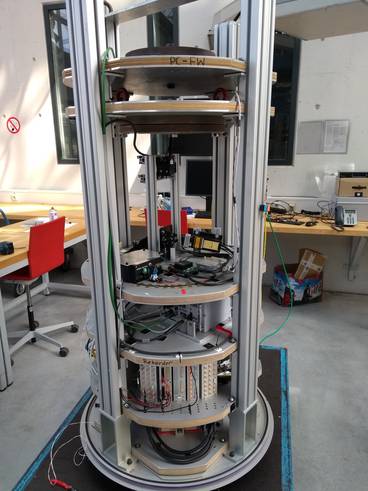Calibration of sample cells for the Soft Matter Dynamics experiment (SoMaDy)

research area: materials sciences
experiment title:
Calibration of Sample Cells for the Soft Matter Dynamics Experiment
experiment acronym: SoMaDy
funding agency: ESA
grant number: CORA - Program
performing organization:
DLR Institute for Materials Physics in Space, Cologne, Germany
prime investigator:
Prof. Dr. Andreas Meyer, Prof. Dr. Matthias Sperl, Dr. Philip Born
experiment objective
abstract
The proposed experiments on granular media in the SMD experiment focus on the generation of steady dynamic states of unsuspended granular media close to the jamming transition. Such steady states cannot be achieved on ground, where gravitation and agitation lead to convection and inhomogeneous dynamics. The dynamics in these steady states onboard the ISS will be investigated using the light scattering diagnostics provided by the SMD experiment. The sample cells for such experiments thus have to provide an agitation mechanism for achieving steady dynamics, and to provide accessibility for the light scattering diagnostics. Previous campaigns tested different agitation mechanisms; the final sample cell will provide agitation by piezo crystals and by a piston. It will be highly valuable to test these agitation mechanisms in a microgravity environment. The coupling of the granular media to the mechanical agitation and the dependency on sample density will be very different without gravitation. The piezo crystals and the piston allow for different amplitudes and frequencies. Prediction of optimal parameter sets are difficult based on ground-based tests, thus the suggested campaigns aim at narrowing the parameter space for suited agitation parameter for the ISS experiments.
In addition, the evaluation of the light scattering diagnostics require knowledge of optical parameters of the samples and the sample cells, like the reflection coefficients at the interface sample cell-granular medium and the randomization length of light in the granular medium. These parameters depend on the packing fraction and homogeneity of the granular sample, thus exact measurement of these parameters has to be performed in microgravity.
related publications
- P. Born, J. Schmitz, M. Bußmann, and M. Sperl, “Drop Tower Setup for Dynamic Light Scattering in Dense Gas-Fluidized Granular Media,” Microgravity Science and Technology, vol. 28, no. 4, pp. 413–420, Aug. 2016.
- P. Born, S. Reinhold, and M. Sperl, “Probing density waves in fluidized granular media with diffusing-wave spectroscopy,” Physical Review E, vol. 94, no. 3, p. 032901, Sep. 2016.
- P. Born, J. Schmitz, and M. Sperl, “Dense fluidized granular media in microgravity,” npj Microgravity, vol. 3, no. 27, doi:10.1038/s41526-017-0030-z, Sep. 2017.
experiment campaigns
experiment year: 2020
number of catapult launches: 8
experiment year: 2019
number of catapult launches: 12
experiment year: 2018
number of catapult launches: 8


 "
"